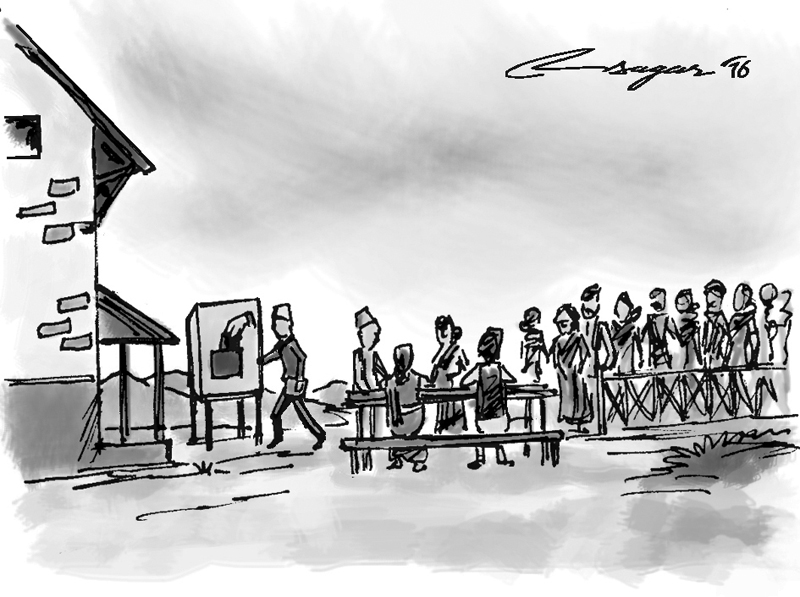Local government bodies: Some questions
During the past 14 years without elected representation at local government bodies or local public service providers, although people saw democratic changes take place they never witnessed accountability and service delivery
Political instability of almost one and half decade badly hit the local government. The failure to understand the rights of the marginalized groups is a serious mistake in the state building process in Nepal.
The fatal results of a weak governance system which has not been able to integrate all sections of Nepali society in state building and development processes have been witnessed in the past one decade.
Some efforts had been made in the past to assess the local governance situation.
The unstable political situation, post-conflict vulnerability, structure of local government bodies and the future of overall local governance system are other factors for good governance. Local bodies in Nepal have continued to remain without elected representatives since 17 July 2002.
In 1999, the Nepal government promulgated a Local Self-Governance Act (LSGA) amidst the Maoist People’s Movement. This introduced a two-tier system of local government, with Village Development Committees (VDCs) and equivalent Municipalities (MUN) as the lower tier, and District Development Committees (DDCs) as the upper tier.
The LSGA envisages full devolution of central-level development functions and responsibilities to these local bodies.
However, local democratization was seriously impeded in 2002 due to violent insurgency; and it was not possible to hold any local elections. It is essential to galvanize public opinion for institutional reform, and push for tangible changes in the political and governance process, stymied because of 14 years of vacuum of elected representations at the local government bodies.
The Local Bodies Restructuring Commission (LBRC) constituted during KP Oli’s government was enjoying power undertaking the job, despite grievances and opposition from various political parties, including the agitating Madhes-centric parties and forces.
The delineation is not for accomplishment of short-term or petty political mileage to anyone, but has long-term ramifications in institutionalizing good governance from grassroots, providing better service delivery to the people especially rural-folks, and establishing local government bodies as the nearest public service provider to the people.
If LBRC misses to address these crucial elements, then the whole purpose of Nepal opting for a federal republican governance system would be defeated.
Already, some questions have been raised about the restructuring of local government bodies, by LBRC such as: i) how far should be the service-centre of the Gaon Palika (Village) or Nagar Palika (Municipality) from the farthest point of any ward?
For example, the current local government bodies, as per the information coming-out, have been demarcated in such a way that the people of the farthest ward point may take 2 to 4 days walking to reach their Goan Palika service centre! In this way, is our federal republican set-up trying to provide service to the people?
Apparently, LBRC has reduced the number of Goan Palika to 650 by eight times, but subsequently increased the territory of Goan Palika by a whopping 800 percent! This would totally jeopardize the present information and service delivery mechanisms at the local level.
However, due to lack of elections, people are deprived of the right to participate in the activities of local and rural development.
The need of fresh election for the local government is necessary to make the local government more accountable, as people perceived that non-elected (nominated) representatives as well as public officers of the local government have not been representing their voices in the overall governance process.
It could lead the local people to frustration and may be the cause of conflict in the future.
The capacity of local government at all level is medium and weak in terms of providing quality service, planning, monitoring and the implementation of rule of law.
Positive and proper use of the Right to Information (RTI) Act in implementing rule of law, executing development interventions, and fulfilling the responsibility of both state and non-state parties is necessary with immense focus on the citizens’ responsibility.
This could also render a quantum leap in access to information and public awareness and expedite the process of service delivery and development.
The core elements of democracy are access to information, citizen’s participation and good governance.
During the past 14 years without elected representation at local government bodies or local public service providers, although people saw democratic changes take place they never witnessed accountability and service delivery.
The democracy and federalism component has been considered here as an integral part of the good governance and rural development. One of the important elements of democratic governance is that it should be closest to the people, and people have the ultimate right to vote.
In a true democracy, citizens within a territory elect representatives who represent the aspirations of the people and make decisions for them. It is a basic principle in all forms of democracy - either direct or a representative electoral system.
Citizens should have a voice in decision-making with respect of their basic human rights.
Acharya is a leader of RPP Nepal who writes on local governance affairs






